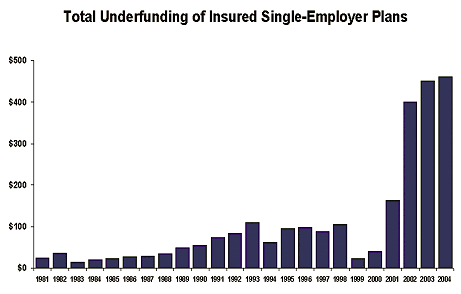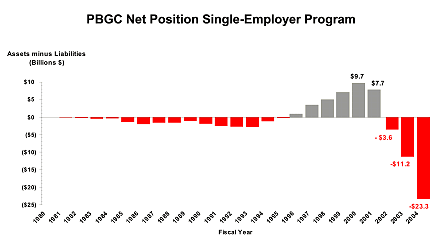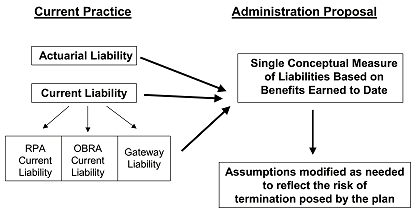|
|
|
|
The pension insurance system is
broken and threatening workers, healthy plan sponsors, and taxpayers. |
|
There are three keys to fixing the
system:
|
Printer Friendly Version
|
-
Reform funding rules – to induce
employers to fully fund their plans
-
Reform insurance premiums -- to
better reflect costs and risks
-
Improve disclosure -- to better
inform workers, investors and regulators
|
|
|
|
|
|
|
|

|
|
…and PBGC has fallen into a deep hole |
|

|
|
|
-
One single, accurate measure of
liabilities valued according to current duration-matched yield curve
of corporate bond rates
-
Assumptions that appropriately
reflect the plan’s risk of termination
-
Plans given a reasonable period of
time to reach their funding targets
-
Sponsors allowed to make additional
deductible contributions during good economic times
-
Underfunded plans or financially
weak sponsors restricted from increasing unfunded benefits
-
Premiums that meet PBGC’s
long-term funding needs
-
Better disclosure of plan
information to workers, markets, and regulators
-
Clarify the treatment of hybrid
(cash-balance) plans to expand pension options
-
Improve PBGC’s standing to enforce
contributions on firms in bankruptcy
|
|
|
|

|
|
|
|

|
|
In an Ongoing plan, employees are assumed to retire and
to choose lump sums as they have in the past. In an At-Risk plan, the
rules will assume that employees will take lump sums and retire as soon as
they can. |
|
Empirical evidence shows that a firm's time spent in
junk bond status is a strong indicator of the likelihood of plan
termination. |
|
|
|
Under the
Administration proposal, plans would annually contribute enough to address
their funding shortfall over a reasonable period of time.
|
|
|
|
Minimum
Required Contribution
|
Maximum
Deductible Contribution
|
|
|
|
|
|
|
|
Percentage Points Below
Required Funding Level (Target) |
Bankrupt
Sponsor |
Junk Grade Sponsor
(At-Risk Liability Target) |
Investment Grade
Sponsor (Ongoing Liability Target) |
|
0 to 19 |
-
No benefit increases
-
No lump sums
-
No accruals
|
|
|
|
20 to 39 |
-
No benefit increases
-
No lump sums
-
No accruals
|
-
No benefit increases
-
No lump sums
|
|
|
40 or worse |
-
No benefit increases
-
No lump sums
-
No accruals
|
|
-
No benefit increases
-
No lump sums
|
|
|
|
-
Flat rate premiums will be adjusted (initially to $30) to reflect the
growth in worker wages since 1991, when the current $19 figure was set. Going forward, the flat rate premium will be indexed for
wage growth
-
Risk based premiums will be charged to each plan based on
underfunding relative to its funding target. The risk-based premium rate will be adjusted periodically by the PBGC’s Board so that
premium revenue is sufficient to cover expected losses and improve PBGC’s financial condition
|
|
|
|
|
|
|
-
Allow PBGC to perfect its lien against missed
contributions while plan sponsor is in bankruptcy
-
Notify participants when plan sponsor files for
bankruptcy, including effect on plans
|
|
|
-
Hybrid plans (e.g., “cash balance” plans) combine the best of defined
benefit and defined contribution
-
Enact the Treasury proposal to a create legal and regulatory environment
that supports continuation and adoption of hybrid plans
-
Establish Employer Retirement Savings Accounts
(ERSAs) that will simplify
the rules surrounding employer-provided portable savings plans
-
Increase worker access to investment education
-
Allow workers in defined contribution plans to diversify out of company
stock after three years
|
|
|
The Administration single-employer pension reform proposal would
make defined-benefit plans a more viable option for employers and workers by achieving: |
-
Sounder long-term pension funding
-
Reduced risk to workers and to the pension insurance system
-
Increased transparency and simplified measurements
-
Improved incentives for sound pension funding and greater flexibility
for employers to fund up in good times
-
Opportunities for sponsors to reduce volatility in required pension
contributions
-
Premiums that meet PBGC’s long term funding needs
-
Reduced risk to the taxpayers of having to bail out the PBGC
|



